宾语补足语讲解(整理)
- 格式:doc
- 大小:45.50 KB
- 文档页数:4
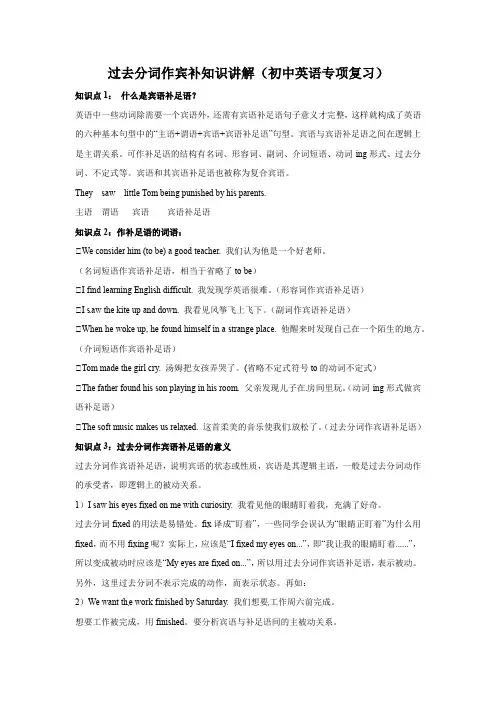
过去分词作宾补知识讲解(初中英语专项复习)知识点1:什么是宾语补足语?英语中一些动词除需要一个宾语外,还需有宾语补足语句子意义才完整,这样就构成了英语的六种基本句型中的“主语+谓语+宾语+宾语补足语”句型。
宾语与宾语补足语之间在逻辑上是主谓关系。
可作补足语的结构有名词、形容词、副词、介词短语、动词-ing形式、过去分词、不定式等。
宾语和其宾语补足语也被称为复合宾语。
They saw little Tom being punished by his parents.主语谓语宾语宾语补足语知识点2:作补足语的词语:①We consider him (to be) a good teacher. 我们认为他是一个好老师。
(名词短语作宾语补足语,相当于省略了to be)①I find learning English difficult. 我发现学英语很难。
(形容词作宾语补足语)①I s aw the kite up and down. 我看见风筝飞上飞下。
(副词作宾语补足语)①When he woke up, he found himself in a strange place. 他醒来时发现自己在一个陌生的地方。
(介词短语作宾语补足语)①Tom made the girl cry. 汤姆把女孩弄哭了。
(省略不定式符号to的动词不定式)①The father found his son playing in his room. 父亲发现儿子在房间里玩。
(动词-ing形式做宾语补足语)①The soft music makes us relaxed. 这首柔美的音乐使我们放松了。
(过去分词作宾语补足语)知识点3:过去分词作宾语补足语的意义过去分词作宾语补足语,说明宾语的状态或性质,宾语是其逻辑主语,一般是过去分词动作的承受者,即逻辑上的被动关系。
1)I saw his eyes fixed on me with curiosity. 我看见他的眼睛盯着我,充满了好奇。
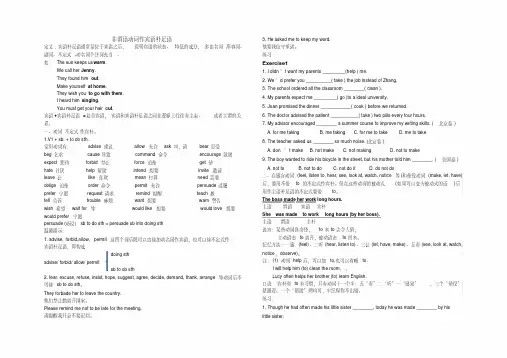
非谓语动词作宾语补足语定义:宾语补足语通常是位于宾语之后,说明宾语的状态、特征的成分,多由名词,形容词、副词、不定式,动名词个分词充当.如:The sun keeps us warm.We call her Jenny.They found him out.Make yourself at home.They wish you to go with them.I heard him singing.You must get your hair cut.宾语+宾语补足语=复合宾语,宾语和宾语补足语之间在逻辑上往往有主表、或者主谓的关系.一、动词不定式作宾补。
1.V1 + sb. + to do sth.常用动词有:advise 建议allow 允许ask 叫,请bear 忍受beg 乞求cause 导致command 命令encourage 鼓励expect 期待forbid 禁止force 迫使get 使hate 讨厌help 帮助intend 想要invite 邀请leave 让like 喜欢mean 打算need 需要oblige 迫使order 命令permit 允许persuade 说服prefer 宁愿request 请求remind 提醒teach 教tell 告诉trouble 麻烦want 想要warn 警告wish 希望wait for 等would like 想要would love 想要would prefer 宁愿persuade (劝说)sb to do sth = persuade sb into doing sth温馨提示:1.advise, forbid,allow, permit 这四个词后既可以直接加动名词作宾语,也可以接不定式作宾语补足语,即构成doing sthadvise/ forbid/ allow/ permitsb to do sth2.fear, excuse, refuse, insist, hope, suggest, agree, decide, demand, thank, arrange 等动词后不可接sb to do sth。
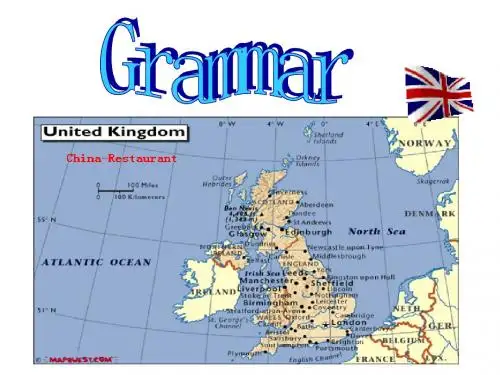
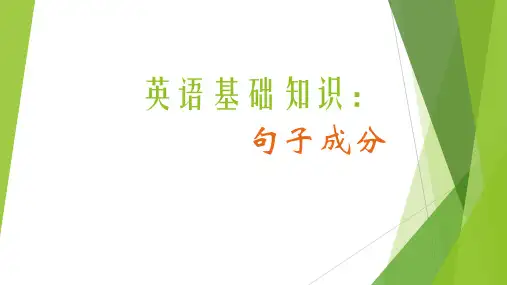
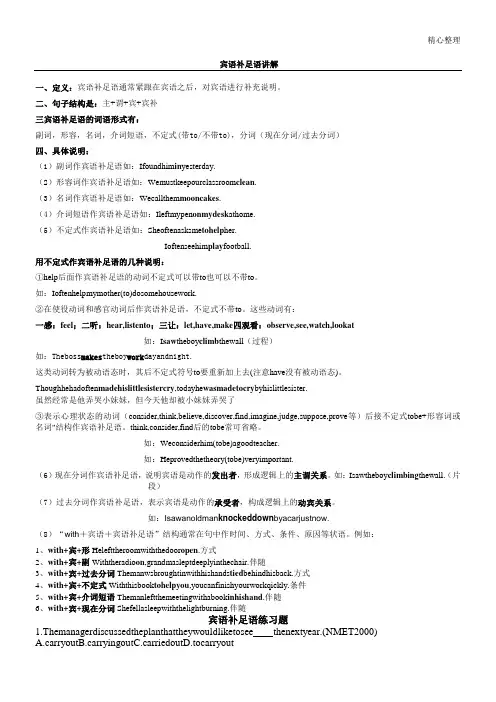
精心整理宾语补足语讲解一、定义:宾语补足语通常紧跟在宾语之后,对宾语进行补充说明。
二、句子结构是:主+谓+宾+宾补三宾语补足语的词语形式有:副词,形容,名词,介词短语,不定式(带to/不带to),分词(现在分词/过去分词)四、具体说明:(1)副词作宾语补足语如:Ifoundhim in yesterday.(2)形容词作宾语补足语如:Wemustkeepourclassroom clean.(3)名词作宾语补足语如:Wecallthem mooncakes.(4)介词短语作宾语补足语如:Ileftmypen onmydesk athome.(5)不定式作宾语补足语如:Sheoftenasksme tohelp her.Ioftenseehim play football.用不定式作宾语补足语的几种说明:①help后面作宾语补足语的动词不定式可以带to也可以不带to。
如:Ioftenhelpmymother(to)dosomehousework.②在使役动词和感官动词后作宾语补足语,不定式不带to。
这些动词有:一感:feel;二听:hear,listento;三让:let,have,make四观看:observe,see,watch,lookat如:I saw theboy climb thewall(过程)如:Theboss makes theboy work dayandnight.这类动词转为被动语态时,其后不定式符号to要重新加上去(注意have没有被动语态)。
Thoughhehadoften madehislittlesistercry,todayhe wasmadetocry byhislittlesister.虽然经常是他弄哭小妹妹,但今天他却被小妹妹弄哭了③表示心理状态的动词(consider,think,believe,discover,find,imagine,judge,suppose,prove等)后接不定式tobe+形容词或名词"结构作宾语补足语。
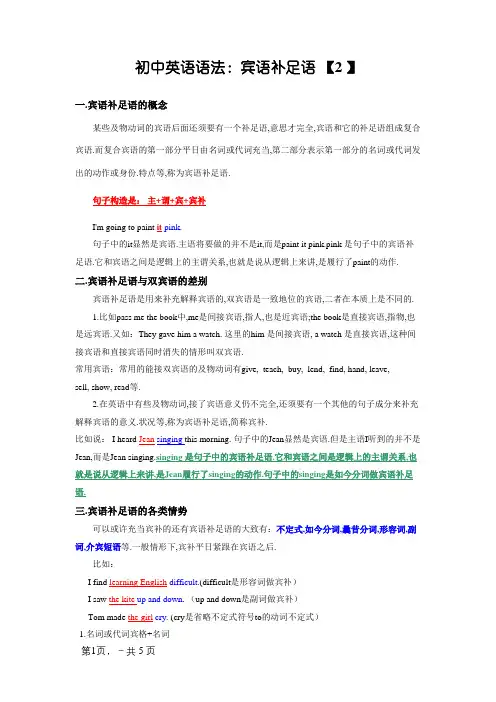
初中英语语法:宾语补足语【2 】一.宾语补足语的概念某些及物动词的宾语后面还须要有一个补足语,意思才完全,宾语和它的补足语组成复合宾语.而复合宾语的第一部分平日由名词或代词充当,第二部分表示第一部分的名词或代词发出的动作或身份.特点等,称为宾语补足语.句子构造是:主+谓+宾+宾补I'm going to paint it pink.句子中的it显然是宾语.主语将要做的并不是it,而是paint it pink.pink 是句子中的宾语补足语.它和宾语之间是逻辑上的主谓关系,也就是说从逻辑上来讲,是履行了paint的动作. 二.宾语补足语与双宾语的差别宾语补足语是用来补充解释宾语的,双宾语是一致地位的宾语,二者在本质上是不同的.1.比如pass me the book中,me是间接宾语,指人,也是近宾语;the book是直接宾语,指物,也是远宾语.又如:They gave him a watch. 这里的him 是间接宾语, a watch 是直接宾语,这种间接宾语和直接宾语同时消失的情形叫双宾语.常用宾语:常用的能接双宾语的及物动词有give, teach, buy, lend, find, hand, leave,sell, show, read等.2.在英语中有些及物动词,接了宾语意义仍不完全,还须要有一个其他的句子成分来补充解释宾语的意义.状况等,称为宾语补足语,简称宾补.比如说: I heard Jean singing this morning. 句子中的Jean显然是宾语.但是主语I听到的并不是Jean,而是Jean singing.singing 是句子中的宾语补足语.它和宾语之间是逻辑上的主谓关系,也就是说从逻辑上来讲,是Jean履行了singing的动作.句子中的singing是如今分词做宾语补足语.三.宾语补足语的各类情势可以或许充当宾补的还有宾语补足语的大致有:不定式,如今分词,曩昔分词,形容词,副词,介宾短语等.一般情形下,宾补平日紧跟在宾语之后.比如:I find learning English difficult.(difficult是形容词做宾补)I saw the kite up and down. (up and down是副词做宾补)Tom made the girl cry. (cry是省略不定式符号to的动词不定式)1.名词或代词宾格+名词They named the baby Jim.We call him Tom.2.名词或代词宾格+形容词They painted the wall white.I always find her happy and gay(高兴).3.名词或代词宾格+介宾短语People praised(赞扬)him as a national hero.The next morning I found him at his machine again.☆4.名词或代词宾格+动词不定式We asked the teacher to explain the difficult sentences again.The teacher helped him(to)see his error(错误).☆5.名词或代词宾格+分词(如今分词或曩昔分词)I heard somebody knocking at the door.He had his ankle sprained while playing football.他踢足球时把脚踝扭伤.请思虑:为什么第一句用的是如今分词而第二句用的是曩昔分词呢四.什么动词后可有宾语补足语:1.在表示心理状况的动词后作宾语补足语.这类动词有:consider, think, believe, discover, find, imagine, judge, suppose, prove等.这类动词后的不定式平日是"to be+形容词或名词"构造,think, consider, find后的to be常可省略. We consider him (to be) a good teacher. 我们以为他是一个好师长教师.He proved that theory(to be) very important. 他证实谁人理论是很主要的.I thought her(to be) nice and honest the first time I met her. 我第一次见到她的时刻就以为她人很好,很说谎.2.在表示情绪状况的动词后作宾语补足语.这类动词有:love, like, prefer, hate, want, wish, expect等.I'd prefer you to leave him alone. 我愿望你不要打搅他.☆3.留意:hope, demand, suggest等动词后面不能接不定式作宾语补足语.I hope you can give me a hand. (宾从)我愿望你能帮我一把.I wish you to give me a hand. 我愿望你能帮我一把.Mr. Li suggested that she should not go there alone. (宾从)李师长教师建议她不要独自去那边.He required us to be present at the meeting. 他请求我们出席会议.☆不定式作宾语补足语的情形:1. 常接带to的动词不定式作宾语补足语的动词有:ask, tell, want, teach, wish等;2. 接不带to的动词不定式作宾语补足语的动词有:see, watch, hear, make, let advise, allow, ask, beg, command, tell, invite, force, oblige, get, help, encourage, persuade, permit, remind, request, order, warn, cause等.如:She often asks me to help her.We don't allow such things to happen again.Most of the parents agree to forbid their children to smoke.I often see him play football.(to省略了)3. 用不定式作宾语补足语的几种解释:①help后面作宾语补足语的动词不定式可以带to也可以不带to.如:I often help my mother(to) do some housework.②在使役动词后作宾语补足语,不定式不带to.这些动词有:一感二听三让四不雅看.一感:feel二听:hear, listen to三让:let, have, make 四不雅看:observe, see, watch, look at .这类动词还有:make, let, have等.转为被动语态时,厥后平日都用带to的不定式 (have没有被动语态).What would you have me do?你要我做什么?She made him give up smoking.她让他戒了烟.Let him do whatever he wishes to do.他想干什么就让他干吧.Though he had often made his little sister cry, today he was made to cry by his little sister.(变成被动语态要把to加上)固然经常是他弄哭小妹妹,但今天他却被小妹妹弄哭了☆分词作宾语补足语用如今分词作宾补,解释宾语是动作的发出者,形成逻辑上的主谓关系;用曩昔分词作宾补,表示宾语是动作的推却者,组成逻辑上的动宾关系.1. 跟分词作宾补的动词有:catch, have get, keep, hear, find, feel, leave, make, want, start, notice, observe, watch, set等.例如:There was so much noise that the speaker couldn’t make himself heard.因为十分吵闹,讲话人没法让人听到他的声音.When he awoke, he found himself being looked after by an old woman.他醒来的时刻发明一位老迈娘正在照料他.2. 几种用曩昔分词作宾语补足语的情形解释:①表示“意欲;敕令”的动词如 like, want, wish, order 等,可用曩昔分词作宾语补足语.The father wants his daughter taught the piano. 这位父亲想让女儿学钢琴.②感官动词see, hear, notice, observe, watch, feel, 等后,可用曩昔分词作宾语补足语.例如:Isaw an old man knocked down by a car just now. 适才我看到一位白叟被车撞倒了.③使役动词 have, get, make, leave, keep 等后,可用曩昔分词作宾语补足语.例如: Have you got your films developed? 你拿菲林去冲洗了没有?☆控制“使役动词 have + 宾语+曩昔分词”的几种寄义在“ have +宾语+曩昔分词”构造中,曩昔分词作宾语补足语, have 也可用 get .这一构造具有以下几种寄义:①意为“主语请别人做某事”.例如:He wants to have his eyes examined tomorrow. 他明天想去检讨眼睛.(“检讨”的动作由大夫来进行)②意为“主语遭受.遭受某一不高兴.不测的工作”.例如:Be careful, or you'll have your hands hurt. 当心,不然会弄伤手的.③意为“使完成某事”,工作既可所以别人做完,也可以由主语参与完成.He had the walls painted this morning. 他今早把墙漆了.(主语本身可能参与)。
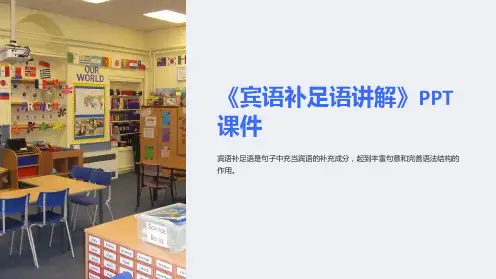
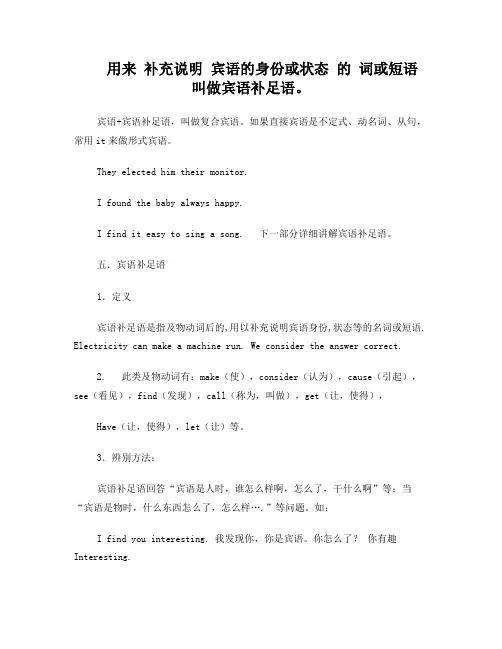
用来补充说明宾语的身份或状态的词或短语叫做宾语补足语。
宾语+宾语补足语,叫做复合宾语。
如果直接宾语是不定式、动名词、从句,常用it来做形式宾语。
They elected him their monitor.I found the baby always happy.I find it easy to sing a song. 下一部分详细讲解宾语补足语。
五.宾语补足语1.定义宾语补足语是指及物动词后的,用以补充说明宾语身份,状态等的名词或短语. Electricity can make a machine run. We consider the answer correct.2. 此类及物动词有:make(使),consider(认为),cause(引起),see(看见),find(发现),call(称为,叫做),get(让,使得),Have(让,使得),let(让)等。
3.辨别方法:宾语补足语回答“宾语是人时,谁怎么样啊,怎么了,干什么啊”等;当“宾语是物时,什么东西怎么了,怎么样….”等问题。
如:I find you interesting. 我发现你,你是宾语。
你怎么了?你有趣Interesting.I saw a book interesting. 我看见一本书,书是宾语。
书怎么样?interesting.4.宾语补足语的构成(1) 名词(包括名词性物主代词):Her father named her Kate.(2) 形容词或形容词短语:They pained their house white.(3) 不定式及其短语:You musn’t force him to lend his money to you.Make, see, have, let, watch, notice, hear, observe等动词后的宾语补足语是不定式时,不加to; help 后的宾补可带也可不带to。
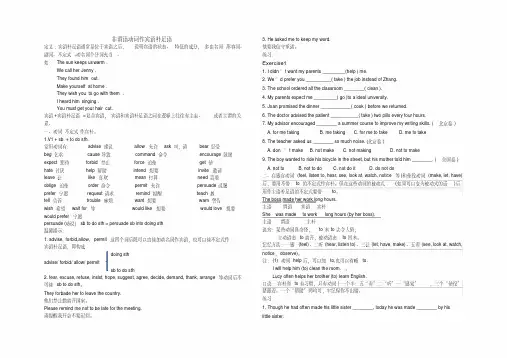
非谓语动词作宾语补足语定义:宾语补足语通常是位于宾语之后,说明宾语的状态、特征的成分,多由名词,形容词、副词、不定式,动名词个分词充当.如:The sun keeps us warm.We call her Jenny.They found him out.Make yourself at home.They wish you to go with them.I heard him singing.You must get your hair cut.宾语+宾语补足语=复合宾语,宾语和宾语补足语之间在逻辑上往往有主表、或者主谓的关系.一、动词不定式作宾补。
1.V1 + sb. + to do sth.常用动词有:advise 建议allow 允许ask 叫,请bear 忍受beg 乞求cause 导致command 命令encourage 鼓励expect 期待forbid 禁止force 迫使get 使hate 讨厌help 帮助intend 想要invite 邀请leave 让like 喜欢mean 打算need 需要oblige 迫使order 命令permit 允许persuade 说服prefer 宁愿request 请求remind 提醒teach 教tell 告诉trouble 麻烦want 想要warn 警告wish 希望wait for 等would like 想要would love 想要would prefer 宁愿persuade (劝说)sb to do sth = persuade sb into doing sth温馨提示:1.advise, forbid,allow, permit 这四个词后既可以直接加动名词作宾语,也可以接不定式作宾语补足语,即构成doing sthadvise/ forbid/ allow/ permitsb to do sth2.fear, excuse, refuse, insist, hope, suggest, agree, decide, demand, thank, arrange 等动词后不可接sb to do sth。
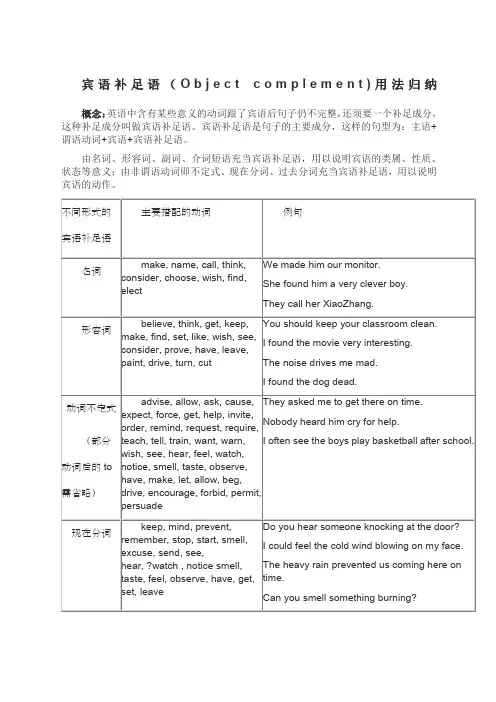
宾语补足语(O b j e c t c o m p l e m e n t)用法归纳概念:英语中含有某些意义的动词跟了宾语后句子仍不完整,还须要一个补足成分,这种补足成分叫做宾语补足语。
宾语补足语是句子的主要成分,这样的句型为:主语+谓语动词+宾语+宾语补足语。
由名词、形容词、副词、介词短语充当宾语补足语,用以说明宾语的类属、性质、状态等意义;由非谓语动词即不定式、现在分词、过去分词充当宾语补足语,用以说明宾语的动作。
①当感官动词和使役动词,如:see hear notice watch hear observe, listen to, feel(感官动词)make have let get(使役动词)接宾补时,不定式的符号to必须省略。
但在被动语态中,动词后要加to。
主动语态:The policeman made him tell everything.被动语态:He was made to tell everything by the policeman.②感官动词see, hear, watch, notice, observe后面的宾语补足语既可跟不带to的动词不定式,也可跟现在分词,其区别在于前者表示“经常性的,习惯性的动作”,后者表示“正在发生的瞬间动作”。
I often hear her sing English songs in the room.Suddenly, Zhang Hua heard someone shouting “Fire! Fire!”③在help后,不定式可以带to,也可不带。
Lucy often helps her brother (to) learn English.④有些动词只能用现在分词作宾语补足语,如:keep, mind, prevent, stop。
动词find, catch等的宾语可由现在分词作宾语补足语。
She caught her son smoking a cigarette.We’d better keep the fire burning.I don’t mind you joking. I like it.The heavy rain prevented us coming here on time.I found him drinking my whisky.⑤hope, demand, suggest等动词后面不能接不定式作宾语补足语。
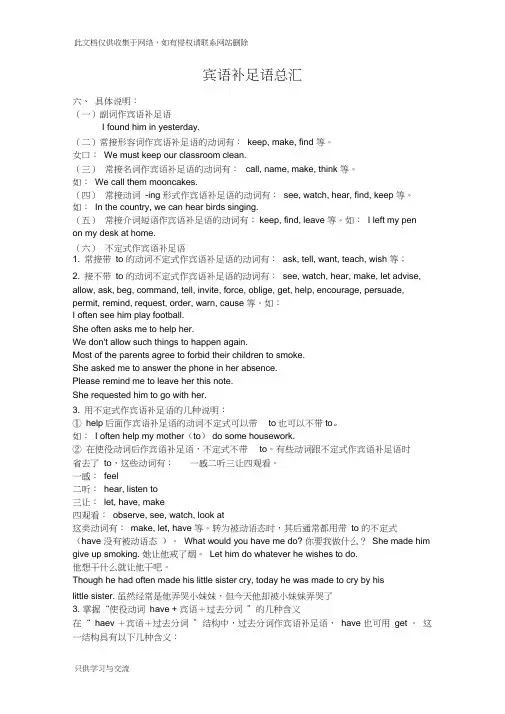
宾语补足语总汇六、具体说明:(一)副词作宾语补足语I found him in yesterday.(二)常接形容词作宾语补足语的动词有:keep, make, find 等。
女口:We must keep our classroom clean.(三)常接名词作宾语补足语的动词有:call, name, make, think 等。
如:We call them mooncakes.(四)常接动词-ing 形式作宾语补足语的动词有:see, watch, hear, find, keep 等。
如:In the country, we can hear birds singing.(五)常接介词短语作宾语补足语的动词有:keep, find, leave 等。
如:I left my penon my desk at home.(六)不定式作宾语补足语1. 常接带to 的动词不定式作宾语补足语的动词有:ask, tell, want, teach, wish 等;2. 接不带to 的动词不定式作宾语补足语的动词有:see, watch, hear, make, let advise, allow, ask, beg, command, tell, invite, force, oblige, get, help, encourage, persuade, permit, remind, request, order, warn, cause 等。
如:I often see him play football.She often asks me to help her.We don't allow such things to happen again.Most of the parents agree to forbid their children to smoke.She asked me to answer the phone in her absence.Please remind me to leave her this note.She requested him to go with her.3. 用不定式作宾语补足语的几种说明:①help后面作宾语补足语的动词不定式可以带to也可以不带to。
宾语补足语宾语补足语是用于增补说明宾语的成分。
宾语补足语经常放在宾语以后,和宾语一同组成复合宾语。
一、常有的能接宾语补足语的词语1.使役动词(1)使役动词 makemake 用作使役动词表示“使”时,可跟复合构造,即“ make 宾+语 +宾语补足语”,此中的宾语补足语能够是形容词、名词、不带 to 的不定式、过去分词。
The heavy rain made it impossible for us to go out.大雨使得我们没法出去。
He couldn ’ t make himself heard above the noise of the traffic在交.通喧闹声中他没法使自己让他人听到。
What makes the grass grow?什么使得草生长?★动词不定式作 make 的宾语补足语时要用省略 to 的形式,但假如用在被动语态中, to 必定不可以省略。
She was made to work twelve hours a day她.被迫每日工作十二个小时。
(2)使役动词 havehave 表示“使得 ,, ”,后来接宾语补足语,常用于以下构造:①have sb. do sth.使/ 让某人做某事②have sb. Doing sth.使/ 让某人向来做某事③have sth. Done 使/ 让某事被做;遭受某种不幸The teacher had the little boy write on the blackboard.老师让这个小男孩在黑板上写。
don’ t have the lights burning all the night.不要让灯彻夜亮着。
He had the bike repaired yesterday.昨天他让人修了自行车。
He had his leg broken in the match.在竞赛中他摔断了腿。
(3)使役动词 leaveleave 用作使役动词,表示“使/ 让,, 保持某种状态”,能够用形容词、名词、介词短语、分词作宾语补足语。
矿产资源开发利用方案编写内容要求及审查大纲
矿产资源开发利用方案编写内容要求及《矿产资源开发利用方案》审查大纲一、概述
㈠矿区位置、隶属关系和企业性质。
如为改扩建矿山, 应说明矿山现状、
特点及存在的主要问题。
㈡编制依据
(1简述项目前期工作进展情况及与有关方面对项目的意向性协议情况。
(2 列出开发利用方案编制所依据的主要基础性资料的名称。
如经储量管理部门认定的矿区地质勘探报告、选矿试验报告、加工利用试验报告、工程地质初评资料、矿区水文资料和供水资料等。
对改、扩建矿山应有生产实际资料, 如矿山总平面现状图、矿床开拓系统图、采场现状图和主要采选设备清单等。
二、矿产品需求现状和预测
㈠该矿产在国内需求情况和市场供应情况
1、矿产品现状及加工利用趋向。
2、国内近、远期的需求量及主要销向预测。
㈡产品价格分析
1、国内矿产品价格现状。
2、矿产品价格稳定性及变化趋势。
三、矿产资源概况
㈠矿区总体概况
1、矿区总体规划情况。
2、矿区矿产资源概况。
3、该设计与矿区总体开发的关系。
㈡该设计项目的资源概况
1、矿床地质及构造特征。
2、矿床开采技术条件及水文地质条件。